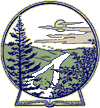
There has been some press lately about Giant Hogweed (Heracleum mantegazzianum) – a number of folks walking at the IBM Glen have asked about it. There is some confusion about related and similar looking plants. First, I’ve seen NO Giant Hogweed at the Glen, only its somewhat less problematic carrot-celery family (Apiaceae) relatives.
There IS Cow Parsnip (Heracleum maximum) which is very large – but smaller than its closely related genus-mate. Never mind that this lesser Heracleum (after Heracles or Hercules) is the one named “maximum”. It’s usually 6 - 7 feet tall with very large leaves, and has just completed blooming (June) its 1.5+ foot wide white compound umbel flowers. Here’s one from the Glen earlier this spring:
Its stem shows no red splotches diagnostic of hogweed - BUT it also contains the same light-activated phytochemicals called furanocoumarins that can cause skin reactions. It should not be handled.
There is also the more diminutive - it can get quite tall, but it’s not big-leaved - related Wild Parsnip (Pastinaca sativa). It’s actually abundant (everyone walking there has seen it)
Again this proper parsnip (“sativa” means “the cultivated variety”) shows no red on its celery-like stem; but it, too, can cause severe light-induced skin reactions (“phytophotodermatitis”) and should not be handled.
The bottom line is that Giant Hogweed is probably not present at the Glen, but these two lesser carrot-celery family members are. They have much less phytochemical punch than Giant Hogweed, but can still cause severe reactions and should be avoided.
-Jeff Smith
Giant Hog Weed & Wild Parsnip


Recipe for Hummingbird Nectar
Recipe for Hummingbird Nectar:
Fill it with a solution that is three parts water and one part sugar (e.g. 1 cup water, 1/4 cup sugar) following these directions:
1. In a pan, bring the water to a boil.
2. Turn off the heat and blend in the sugar, mixing until the solution becomes clear.
3. Allow it to cool until it is lukewarm or room temperature.
4. Empty the old nectar, wash the feeder and fill it with the fresh solution.
5. Hang it outside and watch and enjoy as hummingbirds fight over your nummy, fresh nectar.
Note that you should NEVER add dye to the nectar.

Allen's Hummingbird photographed in Santa Cruz, CA
This leucistic Grackle (right) has small patches of white feathers, but if you didn't see it from the right angle you wouldn't know it was any different from any other Grackle.
Other than impacting their camouflage, the lack of coloration can even cause a bird not to be recognized or accepted by a potential mate. Fortunately, that is obviously not the case with the female Red-tailed Hawk above.
Why is this Hawk White? Is it Albino?
This mother Red-tailed Hawk (left) has a condition known as leucism. That is, a reduction in multiple types of pigment in an animal. Leucism is far more common than albinism which is a complete absence of melanin. Leucistic animals typically have a mix of colored and white patches, but their eye color is not affected. Animals with albinism will have no color at all in their fur or feathers. Albinos also have very pale eyes, which is the best way to differentiate between the two conditions.
Is it Okay to Feed wildlife?
Did you know that feeding bread to ducks and geese can negatively impact their health? Having little nutritional value, it fills them up without offering any benefit. Generally, it's just not a good idea to feed wild animals in our national wildlife refuges, lakes or parks. There are a number of reasons why this is discouraged and many places where it is illegal. For one, it allows animals to become comfortable with humans and can alter their behavior. It can draw them close to public roads where they are more likely to get hit by a car. Additionally, people tend to offer them foods that can actually harm them.
I found a wild baby all alone? What should I do?
Wild animal parents know what's best for raising their young. Often a well-intentioned individual will encounter a young animal alone, assume it is abandoned and remove it from that location. If this happens to you and you are not a licensed rehabilitator, please note your location and call for help. In many cases, removing young animals from their wild homes is unnecessary or even harmful.




